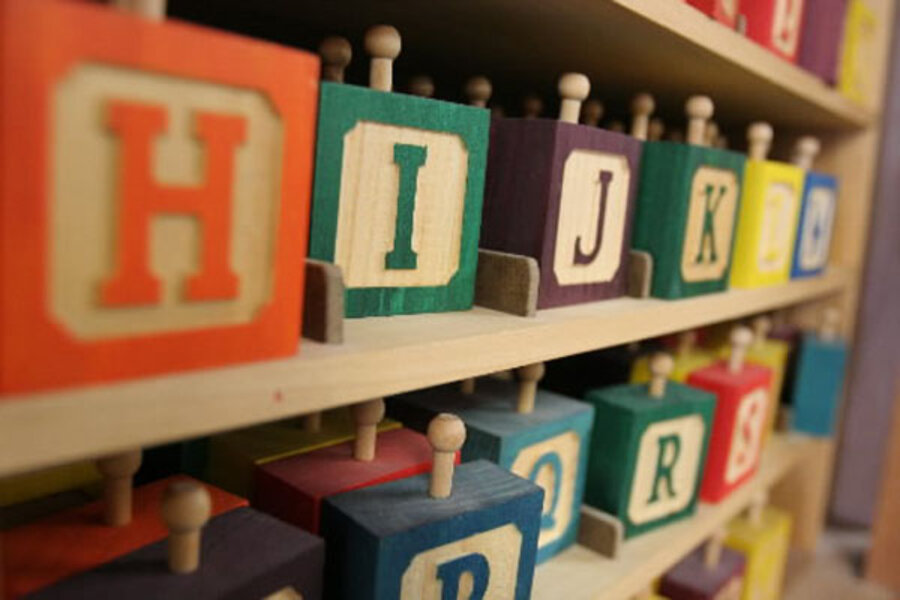Do you know your toddler’s "slave footprint"? Mine has 20 slaves
Loading...
Apparently, I have 47 slaves.
This has come as quite a surprise to me. Like most comfortable and educated Americans, before a few months ago I barely realized that slavery – even as the somewhat more broadly defined “modern day slavery” – still existed. And if I did have a fuzzy idea about the forced labor and human trafficking that exists around the globe, I certainly didn’t think I had any hand in it. I mean, I buy organic. I walk to the grocery story. I even had one of those "(Product) Red" campaign Gap T-shirts, before I shrunk it. I’m a “good” consumer.
RELATED: 5 top childcare options – from nanny to day care
But working on this week’s Monitor magazine cover story about sex trafficking, I came across a website supported by the US State Department that lets people find out their “slavery footprint.” Basically, you enter a bunch of information about your lifestyle – the rooms in your house, the sort of food you eat, and so on - and the super easy website shoots back the number of slaves you use, along with other information.
The results are sobering. But so is this: Of my 47 slaves, who is responsible for almost 20? My toddler.
I should have known I was in trouble when the website started asking me about bath toys. But I saw I was really in for it when I read questions about the number of dresses my 18-month-old baby owns, how many stuffed animals, strollers and soft toys, how many pairs of baby jeans and baby dolls. Every time I clicked – increasingly embarrassed – my slavery count ticked upwards.
RELATED: Are you a Helicopter Parent? Take our quiz!
This was not exactly the image of sweet, innocent childhood that the various retailers of said products would like me to envision.
See, it turns out that many of the toys and baby products that fill American family homes are really bad for other families and kids – kids who live across the world in developing countries. While the nonprofit group Slavery Footprint, which launched the website last year with help from the US government, acknowledges that it doesn’t know whether your particular Winnie-the-Pooh romper was made by someone in slavery-like conditions at a Chinese sweatshop, or by a indentured child servant in India, it says has a pretty good idea of the averages. And those averages, such as the 1.9 “slaves” connected with Baby M’s diapers, are disturbing.
Now, it’s easy to get hyperbolic about the idea of modern day slavery, and there’s a lot of hype about many of the terms surrounding global forced labor issues. (Our cover story zooms in on the way this sensationalism has impacted the fight against sex trafficking.) There are some experts who will quibble over what is “slavery” and what is a really horrible working situation.
But as a parent, it shouldn’t be much comfort to think that Baby’s favorite stuffed animal was made by a toiling 10-year-old girl far away in a dangerous and abusive sweatshop, even if that girl is not officially a “slave.”
Although the Slavery Footprint website does not target specific brands, news stories over the past couple of years have reported about the child labor behind some of American kids’ most popular brands, such as Mattel, Fisher-Price, and Disney. (The brands involved usually say they were unaware of the conditions at their subcontracting factories and always vow to eliminate child labor from their business.)
Critics say that as long as children’s toy and clothing and diaper manufacturing takes place in countries with labor abuse records, our cuddly and cute products will inevitably be tainted. Baby will have a slave footprint.
So what to do?
The answer I've heard regularly is that parents can seek out ethical companies, those that sell sustainably sourced wooden blocks, for instance, or fair trade certified stuffed animals. These products are inevitably more expensive, but retailers count on buyers' desire to lower that slavery footprint as much as possible.
This is a fine approach. But I’d venture that another, perhaps healthier, reaction to the slavery footprint is to simply have less stuff.
The world’s system of forced labor, slavery, debt bondage, trafficking – all of these human rights abuses that involve the desperate living and work conditions of others – goes hand in hand with Americans’ desire to consume. A pattern of consumption, I might add, that studies have shown does us very little good.
We wrote a piece not long ago about a new book, “Life at Home in the Twenty-First Century,” by researchers from the University of California, Los Angeles, and Connecticut College, which looks not only at how Americans today have more things than ever before, but at how the sheer number of objects clutter our homes and stresses out our families.
Add this to the realization that little kids are just as happy – happier, often – with kitchen utensils or ice cubes or the objects they find in the yard or park than they are with the plastic (or even sustainable-helping-the-rainforest-wooden) toys showered upon them, and it seems like there’s a pretty easy way to lower your household’s slavery footprint.
Is this the right way to do it? I mean, will impoverished children across the world be better off if the demand for their products decreases? I’m sure that, like almost every question in this topic area, is the subject of much debate.
But in the meantime, it’s worth considering whether you should give your kids less.
As counter-cultural as that may be in today's US, it might well be better for the world.






